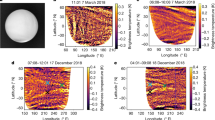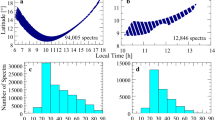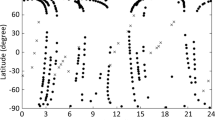Abstract
Venus has no seasons, slow rotation and a very massive atmosphere, which is mainly carbon dioxide with clouds primarily of sulphuric acid droplets. Infrared observations by previous missions to Venus revealed a bright ‘dipole’ feature surrounded by a cold ‘collar’ at its north pole1,2,3,4. The polar dipole is a ‘double-eye’ feature at the centre of a vast vortex that rotates around the pole, and is possibly associated with rapid downwelling. The polar cold collar is a wide, shallow river of cold air that circulates around the polar vortex. One outstanding question has been whether the global circulation was symmetric, such that a dipole feature existed at the south pole. Here we report observations of Venus’ south-polar region, where we have seen clouds with morphology much like those around the north pole, but rotating somewhat faster than the northern dipole. The vortex may extend down to the lower cloud layers that lie at about 50 km height and perhaps deeper. The spectroscopic properties of the clouds around the south pole are compatible with a sulphuric acid composition.
This is a preview of subscription content, access via your institution
Access options
Subscribe to this journal
Receive 51 print issues and online access
$199.00 per year
only $3.90 per issue
Buy this article
- Purchase on Springer Link
- Instant access to full article PDF
Prices may be subject to local taxes which are calculated during checkout



Similar content being viewed by others
References
Taylor, F. W., McCleese, D. J. & Diner, D. J. Polar clearing in the Venus clouds observed from the Pioneer Venus Orbiter. Nature 279, 613–614 (1979)
Elson, L. S. Wave instability in the polar region of Venus. J. Atmos. Sci. 39, 2356–2362 (1982)
Taylor, F. W. in Middle Atmosphere of Venus (eds Schaeffer, K. & Spankuch, D.) 93–97 (Veroffentlichungen des Forchungsberichs Geo- und Kosmoswischenschaften, Vol. 18, Academie-Verlag Berlin, 1990)
Taylor, F. W. et al. Temperature, cloud structure, and dynamics of Venus middle atmosphere by infrared remote-sensing from Pioneer Orbiter. Science 205, 65–67 (1979)
Drossart, P. et al. Scientific goals for the observation of Venus by VIRTIS on ESA/Venus Express mission. Planet. Space Sci. (in the press) 〈http://dx.doi.org/10.1016/j.pss.2007.01.003〉
Piccioni, G. et al. VIRTIS: the Visible and Infrared Thermal Imaging Spectrometer (ESA-SP-1295, ESA Publications Division, Noordwijk, The Netherlands, in the press).
Schofield, J. T. & Diner, D. J. Rotation of Venus’s polar dipole. Nature 305, 116–119 (1983)
Bezard, B. et al. The deep atmosphere of Venus revealed by high-resolution nightside spectra. Nature 345, 508–511 (1990)
Pollack, J. B. et al. Near infrared light from Venus’ nightside: A spectroscopic analysis. Icarus 103, 1–42 (1993)
Allen, D. A. & Crawford, J. W. Cloud structure on the dark side of Venus. Nature 307, 222–224 (1984)
Kamp, L. W., Taylor, F. W. & Calcutt, S. B. Structure of the Venus atmosphere for modelling of night side infrared spectra. Nature 336, 360–362 (1988)
Crisp, D. et al. The nature of the near-infrared features on the Venus night side. Science 246, 506–509 (1989)
Zasova, L. V. et al. Structure of the Venus atmosphere. Planet. Space Sci. 55, 1712–1729 (2007)
Esposito, L. W. et al. in VENUS II: Geology, Geophysics, Atmosphere and Solar Wind Environment (eds Bougher, S. W., Hunten, D. M. & Phillips, R. J.) 415–458 (Univ. Arizona Press, Tucson, 1997)
Murray, B. C. et al. Venus: Atmospheric motion and structure from Mariner 10 pictures. Science 183, 1307–1315 (1974)
Suomi, V. E. & Limaye, S. S. Venus — further evidence of vortex circulation. Science 201, 1009–1011 (1978)
Grinspoon, D. H. et al. Probing Venus’s cloud structure with Galileo NIMS. Planet. Space Sci. 41, 515–542 (1993)
Carlson, R. W. et al. Variations in Venus cloud particle properties — A new view of Venus’s cloud morphology as observed by the Galileo Near-Infrared Mapping Spectrometer. Planet. Space Sci. 41, 477–485 (1993)
Acknowledgements
We acknowledge the work of the entire Venus Express team, which allowed these data to be obtained. We thank ASI, CNES and the other national space agencies that have supported this research.
Author Contributions G.P. and P.D. coordinated the work as Principal Investigators of VIRTIS. A.S.-L. and R.H. contributed to the dynamics calculation and to Supplementary Fig. 1. F.W.T., C.F.W. and L.Z. contributed to the comparison with earlier data and to the finalization of the paper. D.G. contributed to the temperature retrieval model and calculation, M.M. and A.A. contributed to the thermal structure, and S.L. contributed to the coordination of the dynamics study. All authors contributed equally to the planning of the work and data analysis.
Author information
Authors and Affiliations
Consortia
Corresponding author
Supplementary information
Supplementary Figure
The file contains the Supplementary Figure 1. This figure shows the structure of the dipole at different wavelengths on both night and day sides simultaneously. The images have been processed into a polar projection with the same relative size. Spectra in the infrared range from 1 to 5 microns are also shown in two different regions of the southern polar area. (PDF 163 kb)
Rights and permissions
About this article
Cite this article
Piccioni, G., Drossart, P., Sanchez-Lavega, A. et al. South-polar features on Venus similar to those near the north pole. Nature 450, 637–640 (2007). https://doi.org/10.1038/nature06209
Received:
Accepted:
Published:
Issue Date:
DOI: https://doi.org/10.1038/nature06209
This article is cited by
Thermal structure of the Venusian atmosphere from the sub-cloud region to the mesosphere as observed by radio occultation
Scientific Reports (2020)
Planetary-scale streak structure reproduced in high-resolution simulations of the Venus atmosphere with a low-stability layer
Nature Communications (2019)
Venus Atmospheric Thermal Structure and Radiative Balance
Space Science Reviews (2018)
Clouds and Hazes of Venus
Space Science Reviews (2018)
Venus: The Atmosphere, Climate, Surface, Interior and Near-Space Environment of an Earth-Like Planet
Space Science Reviews (2018)
Comments
By submitting a comment you agree to abide by our Terms and Community Guidelines. If you find something abusive or that does not comply with our terms or guidelines please flag it as inappropriate.



